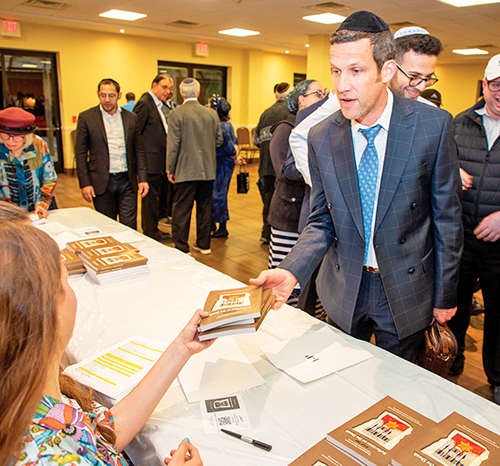
Highland Park’s Congregation Ahavas Achim commemorated Yom HaShoah with a launch of the book “Sefer Zikaron: Reflections on the Shoah.” Over a year in the making, the 214-page volume contains 37 articles and stories written by members of the congregation, recounting their own and/or their family’s experiences during the Shoah.
The commemoration was held after Mincha on Shabbat, May 4, and continued with Havdala and a dessert reception moderated by Susan Hornstein, featuring speakers including Rabbi Steven Miodownik, Miriam Oles, Steve Kolb, Eliot Frank, Maayan Flancbaum and Helene Lochspeiser. Planning team members included Keren Avery, Michael Rosenberg, Karen Small and Rosey Bell.
Oles thought of the book idea and brought it up to friend and fellow congregant Rosenberg, whose parents were from Germany. With confirmation that the idea was sound, Oles met with Rabbi Miodownik to discuss what she had in mind, and the project was born. Never having done anything like this before, she had no idea that it would take as long as it did, coming out nearly a year later than anticipated.
The results are well worth the wait. The softcover book is professionally printed and includes front- and back-cover artworks by a Holocaust survivor, Kolb’s father. The art conveys the solemnity of the subject matter while celebrating the survival of Jewish life. The essays are no longer than several pages each, and most are accompanied by family photographs that bring personal history to life. The stories were edited by Bell to provide a unifying tone to the book without sacrificing the emotion. The narratives are especially compelling; it is impossible to pick up the book and read only one. Readers are drawn into each story and feel as though they are part of the family.

“Sefer Zikaron.” (Credit: Mason Resnick)
With concept in hand, Oles and the committee sought to frame what the actual book would look like. Avery had been to an out-of-town bat mitzvah, where the girl created a book about her family and friends. A call to the printer led to the discovery that the cost would be prohibitive, but would be manageable if they could do the layout themselves and have the volume be print-ready. Kolb was able to use his technical skills to put it all together and the theme and format developed over time.
The next hurdle was to get the essays. Oles noted that many of the stories were emotionally hard on the families. Many Holocaust survivors were loath to speak about their experiences. Many have chosen to look forward and avoid the past. But slowly and steadily, the stories came in.
“The importance of this project is to record these memories before they are lost,” said Oles. “It is important that these stories not be forgotten. It is important to grab the information and preserve it. Unless we document it now, the knowledge won’t be there to pass to our children.”
Several interim deadlines were missed, but the decision was made to aim for the quality product that resulted. When the cover artworks were selected, the project began to come together quickly as the themes gelled. “Every shul should do this,” said Oles. “We are the last generation who knows the survivor generation firsthand. We have to carry the memories and share them.
“We barely scratch the surface with the stories in this book,” Oles added. “In nearly every synagogue … you will find people descended from Holocaust survivors. Nearly one in three Jews in the world were killed by the Nazis, leaving so many impacted.” Oles and the committee hope that other synagogues will be inspired to host a similar project.
Flancbaum, the youngest contributor, said at the reception: “It was really amazing to learn about Bubbie Yetta and Zayde Max’s lives before the war—about their parents, their brothers and sisters, and what life was like. And of course, it was meaningful to learn about how they survived the Holocaust and how strong they were.” As the great-granddaughter of survivors, Flancbaum felt it was important to “make sure the history of her family is written down so that my sister, my cousins and I can learn about how special our family is.”
For some submissions, it was the first time the survivor spoke about what happened to them. Grown children interviewed their parents and heard their stories for the first time. Parents had kept their children from learning what happened because of guilt or to protect them from learning about the atrocities they went through.
Contributor Milt Erdfarb, of Highland Park, said that the timing of the publication was very special for his family. He presented the book to his grandson at his bar mitzvah that week. The grandson is named after Erdfarb’s father and his wife Debbie’s father, who are both memorialized in “Sefer Zikaron.”
Oles concluded: “It took a village to produce this book.”
For more information, contact the synagogue office at 732-247-0532.
Deborah Melman is a staff writer at The Jewish Link.











